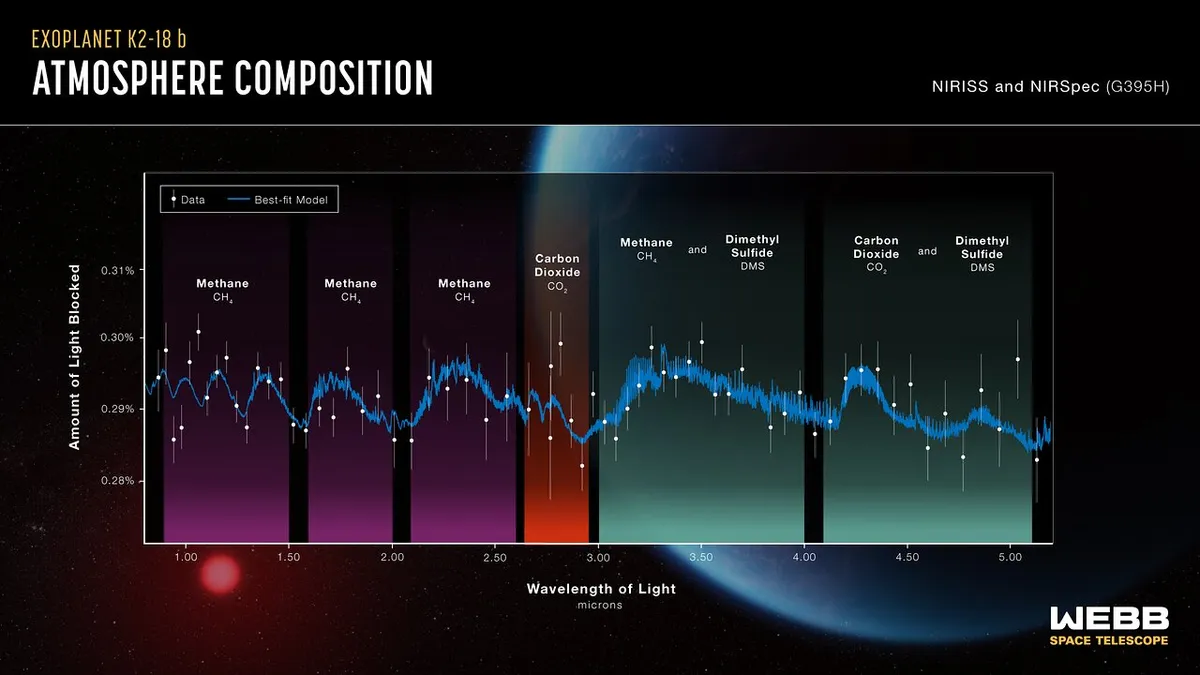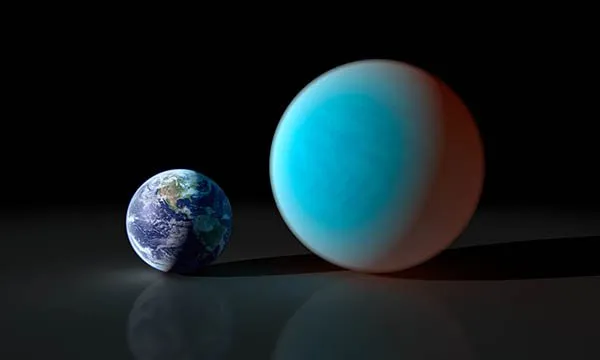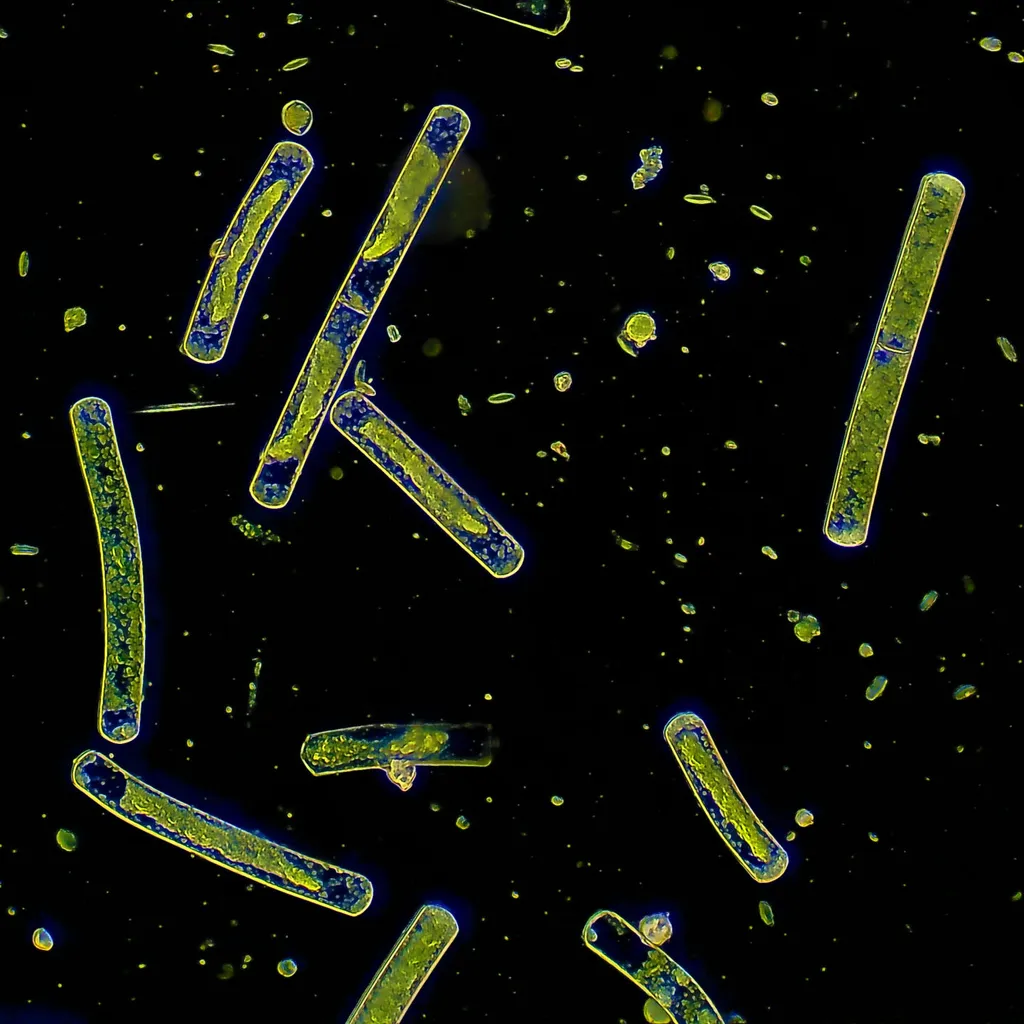A tantalising sign of alien life may have just been discovered on a distant exoplanet by NASA’s James Webb Space Telescope (JWST).
The telescope has made a potential detection of dimethyl sulphide (DMS) – a chemical that, on Earth, is only produced by life – in the atmosphere of potentially habitable world, K2-18 b.
However, the discovery team were keen to emphasise the detection is still only tentative, requiring more data to confirm.
The observations did, however, make more robust detections of carbon dioxide and methane, suggesting the planet could be home to a liquid water ocean.

“These results are the product of just two observations of K2-18 b, with many more on the way,” says Savvas Constantinou from the University of Cambridge, who took part in the study.
“This means our work here is but an early demonstration of what Webb can observe in habitable-zone exoplanets.”
What kind of planet is K2-18 b?
K2-18b is 120 lightyears away and takes around 33 days to orbit its cool dwarf star.
It is 8.6 times the mass of Earth and 2.6 times its radius, making it a sub-Neptune.
These are planets with masses between Earth and Neptune that appear to be common in the Galaxy.
As there are no examples of these kinds of worlds in our Solar System planetary scientists have little idea of what either they might be like, meaning the worlds have become an area of intense study.

Previous observations by Hubble in 2019 suggested K2-18 b has an atmosphere.
This makes it a prime target to learn more about these kinds of worlds as JWST is able to detect which chemicals might exist within that atmosphere.
How did JWST examine K2-18 b’s atmosphere?
JWST watches planets as they pass in front of (or transits) their stars.
As a planet transits, some of the starlight passes through its atmosphere, during which some of the chemicals in the atmosphere leave behind a signature in the light.
Astronomers are able to interpret these signatures to work out the composition of the atmosphere of these distant worlds.
Discover how you can detect exoplanets from your own back garden.

JWST detected various carbon molecules in K2-18 b’s atmosphere, including carbon dioxide and methane, but little ammonia.
This is what you would expect to see on a Hycean exoplanet – worlds up with up to 10 times the mass of Earth with a hydrogen atmosphere and which are thought to be covered with a liquid water ocean.
These are thought to be one of the most likely places to find life beyond Earth.
“Our findings underscore the importance of considering diverse habitable environments in the search for life elsewhere,” explained Nikku Madhusudhan, from University of Cambridge who led the study.
“Traditionally, the search for life on exoplanets has focused primarily on smaller rocky planets, but the larger Hycean worlds are significantly more conducive to atmospheric observations.”

Did JWST find life on K2-18 b?
JWST’s observations also found a hint of dimethyl sulphide (DMS).
Here on Earth, the chemical is only known to be produced by life, with the bulk of the chemical in the planet’s atmosphere created by tiny marine algae, phytoplankton.
This detection, however, was not as robust as the others and so will require further validation.
“Upcoming [JWST] observations should be able to confirm if DMS is indeed present in the atmosphere of K2-18b at significant levels,” says Madhusudhan.

Even if DMS is present, that doesn’t mean that life has been detected on K2-18 b. Though there are no known geological or chemical processes on Earth that produce DMS naturally, the same may not be true on a sub-Neptune.
The planet is also very close to its star, meaning it is bombarded with a great deal of high-energy radiation, which any organisms on its surface would have to be able to survive.
It’s also worth noting that the planet is 120 lightyears away, meaning that even if we could travel at nearly the speed of light, it would take more than a lifetime to reach the planet.
However, the discovery is an exciting first step on the journey towards finding life beyond our planet.
“Our ultimate goal is the identification of life on a habitable exoplanet, which would transform our understanding of our place in the universe,” concluded Madhusudhan.
“Our findings are a promising step towards a deeper understanding of Hycean worlds in this quest.”
